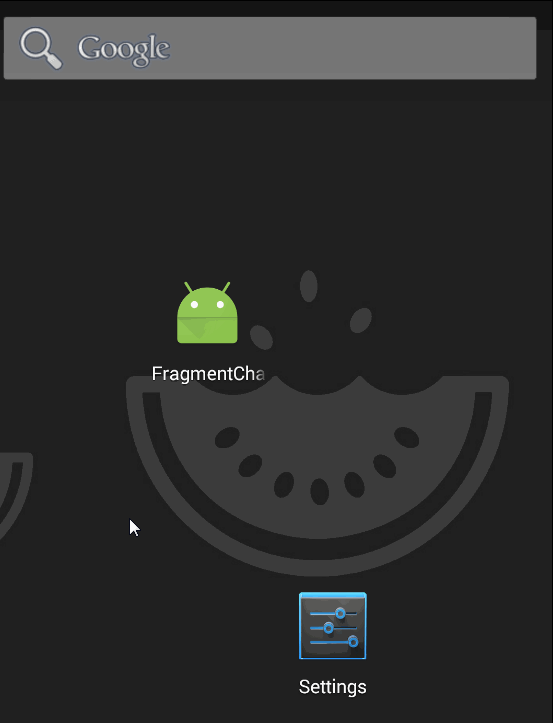fragment切换?不就是Viewpager+fragment吗?是的这是很大多数App采用的切换的组合方式。但是Viewpager+fragment切换的的生命周期十分混乱,这就是会引发很多的坑!如果在一些不需要切换的动画的情况下,采用FragmentTransaction动态切换是一个不错的选择
拓展
先来看看有哪些切换的方案吧。又有哪些问题
(一)预先写在布局里面
布局文件1
2
3
4
5
6
7
8
9
10
11
12
13
14
15
16
17
18
19
20
21
22
23
24
25
26
27<LinearLayout xmlns:android="http://schemas.android.com/apk/res/android"
xmlns:tools="http://schemas.android.com/tools"
android:layout_width="match_parent"
android:layout_height="match_parent"
android:background="@drawable/activity_bg"
android:orientation="vertical" >
<fragment
android:id="@+id/fragement_main"
android:name="net.loonggg.fragment.FragmentMain"
android:layout_width="fill_parent"
android:layout_height="fill_parent"
android:layout_weight="10" />
<fragment
android:id="@+id/fragement_search"
android:name="net.loonggg.fragment.FragmentSearch"
android:layout_width="fill_parent"
android:layout_height="fill_parent"
android:layout_weight="10" />
<fragment
android:id="@+id/fragement_setting"
android:name="net.loonggg.fragment.FragmentSetting"
android:layout_width="fill_parent"
android:layout_height="fill_parent"
android:layout_weight="10" />
java文件1
2
3
4
5
6
7mFragments[0] = fragmentManager.findFragmentById(R.id.fragement_main);
mFragments[1] = fragmentManager.findFragmentById(R.id.fragement_search);
mFragments[2] = fragmentManager
.findFragmentById(R.id.fragement_setting);
fragmentTransaction = fragmentManager.beginTransaction()
.hide(mFragments[0]).hide(mFragments[1]).hide(mFragments[2]);
fragmentTransaction.show(mFragments[0]).commit();
这种方案的问题就是在如果我的某个Fragment更换了,改动的涉及到两个文件,而且也不能进行动态加载,局限性比较大。
(二)Replace替换1
2
3
4
5
6
7
8
9
10
11
12
13
14
15private void replaceFragment(Fragment newFragment) {
FragmentTransaction trasection = getFragmentManager().beginTransaction();
try {
//FragmentTransaction trasection =
getFragmentManager().beginTransaction();
trasection.replace(R.id.linearLayout2, newFragment);
trasection.addToBackStack(null);
trasection.commit();
} catch (Exception e) {
// TODO: handle exception
}
}
这样总没问题了吧?这种方案的问题在于每次调用replace方法时Fragment的生命周期会重走。这在现实开发中是不允许的。
解决方案
build gradle1
compile 'com.android.support:support-v4:20.0.0'
布局文件1
2
3
4
5
6
7
8
9
10
11
12
13
14
15
16
17
18
19
20
21
22
23
24
25
26
27
28
29
30
31
32
33
34
35
36
37
38
39
40
41
42
43
44
45
46
47
48
49
50
51
52
53
54
55
56
57
58
59
60
61
62
63
64
65
66
67
68
69
70
71
72<RelativeLayout xmlns:android="http://schemas.android.com/apk/res/android"
xmlns:tools="http://schemas.android.com/tools"
android:layout_width="match_parent"
android:layout_height="match_parent"
tools:context=".MainActivity">
<LinearLayout
android:id="@+id/top"
android:layout_width="match_parent"
android:layout_height="50dp"
android:orientation="horizontal">
<LinearLayout
android:id="@+id/tab1"
android:layout_width="match_parent"
android:layout_height="match_parent"
android:layout_weight="1"
android:background="@drawable/selector_tab"
android:gravity="center_horizontal|center_vertical"
android:orientation="horizontal">
<TextView
android:layout_width="wrap_content"
android:layout_height="wrap_content"
android:text="选项一" />
</LinearLayout>
<LinearLayout
android:id="@+id/tab2"
android:layout_width="match_parent"
android:layout_height="match_parent"
android:layout_weight="1"
android:background="@drawable/selector_tab"
android:gravity="center_horizontal|center_vertical"
android:orientation="horizontal">
<TextView
android:layout_width="wrap_content"
android:layout_height="wrap_content"
android:layout_gravity="center_vertical|center_horizontal"
android:text="选项二" />
</LinearLayout>
<LinearLayout
android:id="@+id/tab3"
android:layout_width="match_parent"
android:layout_height="match_parent"
android:layout_weight="1"
android:background="@drawable/selector_tab"
android:gravity="center_horizontal|center_vertical"
android:orientation="horizontal">
<TextView
android:layout_width="wrap_content"
android:layout_height="wrap_content"
android:layout_gravity="center_vertical|center_horizontal"
android:text="选项三" />
</LinearLayout>
</LinearLayout>
<FrameLayout
android:id="@+id/fragment"
android:layout_width="match_parent"
android:layout_height="match_parent"
android:layout_below="@+id/top" />
</RelativeLayout>
Activity
以下采用的方式是预先将Fragment加入集合中,切换时从集合取出Fragment添加到FragmentTransaction事物中,每次加入的时候判断是否已经添加到FragmentTransaction中,存在则调用show,并将上一个fragment隐藏。1
2
3
4
5
6
7
8
9
10
11
12
13
14
15
16
17
18
19
20
21
22
23
24
25
26
27
28
29
30
31
32
33
34
35
36
37
38
39
40
41
42
43
44
45
46
47
48
49
50
51
52
53
54
55
56
57
58
59
60
61
62
63
64
65
66
67
68
69
70
71
72
73
74
75public class MainActivity extends FragmentActivity implements View.OnClickListener {
private LinearLayout tab1, tab2, tab3;
private int currentIndex = 0;
private ArrayList<Fragment> fragmentArrayList;
private Fragment mCurrentFrgment;
@Override
protected void onCreate(Bundle savedInstanceState) {
super.onCreate(savedInstanceState);
setContentView(R.layout.activity_main);
initView();
initFragment();
}
private void initView() {
tab1 = (LinearLayout) findViewById(R.id.tab1);
tab1.setOnClickListener(this);
tab1.setTag(0);
tab2 = (LinearLayout) findViewById(R.id.tab2);
tab2.setOnClickListener(this);
tab2.setTag(1);
tab3 = (LinearLayout) findViewById(R.id.tab3);
tab3.setOnClickListener(this);
tab3.setTag(2);
}
private void initFragment() {
fragmentArrayList = new ArrayList<Fragment>(3);
fragmentArrayList.add(new Tab1Fragment());
fragmentArrayList.add(new Tab2Fragment());
fragmentArrayList.add(new Tab3Fragment());
tab1.setSelected(true);
changeTab(0);
}
@Override
public void onClick(View v) {
changeTab((Integer) v.getTag());
}
private void changeTab(int index) {
currentIndex = index;
tab1.setSelected(index == 0);
tab2.setSelected(index == 1);
tab3.setSelected(index == 2);
FragmentTransaction ft = getSupportFragmentManager().beginTransaction();
//判断当前的Fragment是否为空,不为空则隐藏
if (null != mCurrentFrgment) {
ft.hide(mCurrentFrgment);
}
//先根据Tag从FragmentTransaction事物获取之前添加的Fragment
Fragment fragment = getSupportFragmentManager().findFragmentByTag(fragmentArrayList.get(currentIndex).getClass().getName());
if (null == fragment) {
//如fragment为空,则之前未添加此Fragment。便从集合中取出
fragment = fragmentArrayList.get(index);
}
mCurrentFrgment = fragment;
//判断此Fragment是否已经添加到FragmentTransaction事物中
if (!fragment.isAdded()) {
ft.add(R.id.fragment, fragment, fragment.getClass().getName());
} else {
ft.show(fragment);
}
ft.commit();
}
}
fragment1
2
3
4
5
6
7
8
9
10
11
12
13
14
15
16
17
18
19
20
21
22
23
24
25
26
27
28
29
30
31
32
33
34
35
36
37
38
39
40
41public class Tab1Fragment extends Fragment {
public Tab1Fragment() {
}
@Override
public void onCreate(Bundle savedInstanceState) {
super.onCreate(savedInstanceState);
}
@Override
public View onCreateView(LayoutInflater inflater, ViewGroup container,
Bundle savedInstanceState) {
return inflater.inflate(R.layout.fragment_tab1, container, false);
}
@Override
public void onViewCreated(View view, Bundle savedInstanceState) {
super.onViewCreated(view, savedInstanceState);
final ProgressBar progressBar = (ProgressBar) view.findViewById(R.id.progressbar);
final TextView tv = (TextView) view.findViewById(R.id.tv);
new Handler().postDelayed(new Runnable() {
@Override
public void run() {
progressBar.setVisibility(View.GONE);
tv.setVisibility(View.VISIBLE);
}
}, 2000);
}
@Override
public void onAttach(Activity activity) {
super.onAttach(activity);
}
@Override
public void onDetach() {
super.onDetach();
}
}
这样做的好处是,每个Fragment切换只进行一次初始化。
效果图
